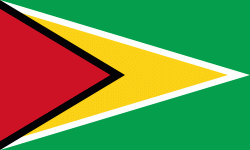Flag of Guyana
The flag of Guyana, known as The Golden Arrowhead, has been the national flag of Guyana since May 1966 when the country became independent from the United Kingdom. It was designed by Whitney Smith, an American vexillologist (though originally without the black and white fimbriations, which were later additions suggested by the College of Arms in the United Kingdom). The proportions of the national flag are 3:5. The colours are symbolic, with red for zeal and dynamism, gold for mineral wealth, green for agriculture and forests, black for endurance, and white for rivers and water.
The civil air ensign is a copy of the British Civil Air Ensign, with the Guyanese flag in the canton. The naval ensign of Guyana is a version of the national flag, with proportions of 1:2.
As part of the British Empire, Guyana's flag was a Blue Ensign with the colonial badge in the fly. An unofficial red version was used at sea. The first flag was introduced in 1875 and was changed slightly in 1906 and 1955. Like all British Ensigns, the colonial flags of Guyana were all ratio 1:2.
The civil air ensign is a copy of the British Civil Air Ensign, with the Guyanese flag in the canton. The naval ensign of Guyana is a version of the national flag, with proportions of 1:2.
As part of the British Empire, Guyana's flag was a Blue Ensign with the colonial badge in the fly. An unofficial red version was used at sea. The first flag was introduced in 1875 and was changed slightly in 1906 and 1955. Like all British Ensigns, the colonial flags of Guyana were all ratio 1:2.
National flag
Country - Guyana
Warning: getimagesize(/Image/Map/MP3378535.gif): failed to open stream: No such file or directory in /home/mapnlee7/public_html/MAPNALL/article.php on line 532
 |
 |
The region known as "the Guianas" consists of the large shield landmass north of the Amazon River and east of the Orinoco River known as the "land of many waters". Nine indigenous tribes reside in Guyana: the Wai Wai, Macushi, Patamona, Lokono, Kalina, Wapishana, Pemon, Akawaio and Warao. Historically dominated by the Lokono and Kalina tribes, Guyana was colonised by the Dutch before coming under British control in the late 18th century. It was governed as British Guiana, with a mostly plantation-style economy until the 1950s. It gained independence in 1966, and officially became a republic within the Commonwealth of Nations in 1970. The legacy of British rule is reflected in the country's political administration and diverse population, which includes Indian, African, Indigenous, Chinese, Portuguese, other European, and various multiracial groups. In 2017, 41% of the population of Guyana lived below the poverty line.
